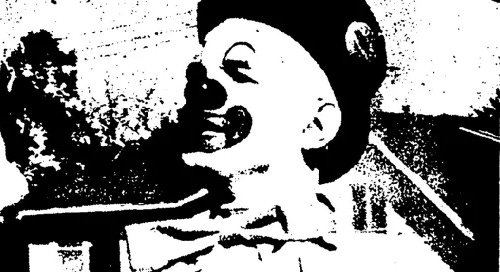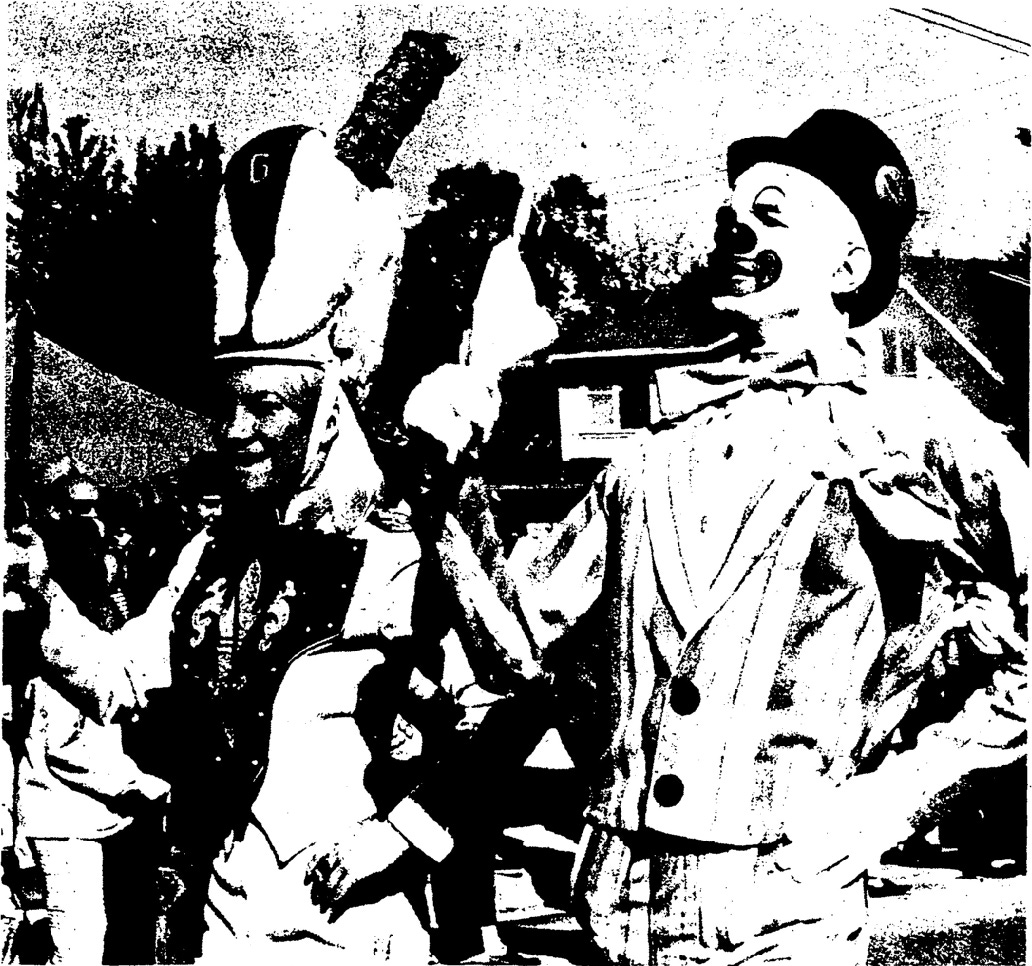“‘Laugh, Clown, Laugh’ proves Contagious with Zero Zilisch” from the August 7, 1969 Door County Advocate
A FAVORITE PLOY of Zero the Clown is to humorously harass other performers in a parade, like he’s doing here to Gibraltar Majorette Wendy Woldt. —Advocate
‘Laugh, Clown, Laugh’ proves Contagious with Zero Zilisch
By KETA STEEBS
Diane Zilisch is married to a two-faced man!
Her husband Kenneth, an unassuming, pleasant person with attractive features, is, by donning greasepaint, a top hat and striped suit, that extrovert of extroverts—Zero the Clown. If you’ve seen Door county parades this summer you’ve seen Zero—now meet Ken.
A native of Beaver Dam, this many-faceted young man is a senior at Layton Art School, Milwaukee, where he specializes in commercial art. His talent led him to Sturgeon Bay and the Advocate where he is spending the summer illustrating advertising brochures. Versatile craftsman that he is, Ken is equally at home working with acrylics, watercolors, oils and pastels. Portraits done in charcoal or pencil rank with those of professionals.
“I’ve been drawing since my knee-high to grasshopper days,” says Ken, “and my love for clowning must have been instilled in me since babyhood.”
As a youngster, circus-smitten Kenneth sat through “The Greatest Show on Earth” four times, collected Bozo comic books and admired Emmett Kelly as the greatest man alive.
“He was a sad clown and I always wanted to be the happy type but I learned a lot by watching Emmett Kelly,” Ken says thoughtfully. “He could make people forget their troubles.”
The ability to make people laugh and an affinity for marching were two reasons Ken learned to clown. The latter talent was revealed when Mr. Zilisch be came Airman Zilisch and strutted with fellow soldiers in a crack drill team.
“This was at Goodfellow Air Force Base in San Angelo, Texas, and I spent a good eight months learning how to march with the old razzle-dazzle. I loved that heavy beat for the left foot and really looked forward to passing in review,” Ken says.
Of course, the fact that I got to wear a gold braid and march at the head of my column may have had a lot to do with it.”
While stationed with the Air Force in Okinawa he met the “Island Jesters”—a jovial group consisting of about 20 clowns from all branches of the service. He was encouraged to join that elite company by one of the boys in his barracks who performed as “Tillie the Clown” and impressed Ken with his antics.
“Everything Tillie could do looked like fun,” Ken admits. “He could march with dignity, take a sprawling prat fall and get up and march again without losing his savoir-faire.”
Two older men in Zilisch’s outfit were ex-clowns and circus roustabouts. One had performed for Ringling Brothers and the other had spent at least 25 years on the tanbark trail. Both recognized their young protege’s talent and initiated him into the fine art of applying greasepaint.
“A thin film is all that’s needed. Heavy make-up either runs off or cakes on your face. Of course, you have to know what kind of features you want before applying greasepaint and I spent untold hours sketching Zero’s features before I had them down pat.”
Ken points out that the sole rule in making up was never to copy another clown’s face—an unwritten law which protects the originator.
The face behind the mask
Each performer is a definite character and each perfects his own act.
“We were taught how to dress, act, tumble and perform without talking. Everything we do is exaggerated pantomime and silence is the hardest part to learn,” Ken reflects.
Zero’s face, a now familiar sight, has gradually taken on added character from that of Ken’s original sketches. The round, red, button nose is sharply emphasized as are the highly arched black brows, prominent ears and oversize (but smiling) red mouth.
After designing his face. Ken’s next job was to create his own unusual costume. He decided on a gaily striped, tuxedo-type suit made of a sturdy canvas. He knew it would have to take rough treatment and wanted it made with skill and care—a difficult task in Okinawa.
“I spent an entire day, bolts of cloth under my arm and sketches in my hand, looking for a tailor who could make my suit,” Ken says. “I finally found a family of five (parents and three children) who agreed to tackle the job and I couldn’t have made a better choice. They did such beautiful work I’m still wearing the same suits.
He explained that each seam is double stitched, the stripes line up perfectly from coat to pants, and room has been allowed for future expansion.
“I might get fatter,” Ken says briefly.
He also reveals that some day he might wish to change Zero from a tall slender clown to a fat round clown with the addition of a strategically placed pillow—providing he doesn’t add a paunch of his own. (A possibility which worries his wife—the former Diane Dickinson of Sturgeon Bay.)
Zero’s suit developed in stages. From Okinawa Ken was sent to the Philippines and purchased his impressive top hat, shirt, spectacular tie and other accessories in that island paradise. While in the Philippines he switched from wearing tennis shoes to sturdy military boots.
“Too many people stepped on my toes and besides, everytime it rained (which was often) my feet got soaking wet. Boots look better with my tuxedo anyway,” Ken says with a grin.
Zero’s repertoire of tricks developed rapidly. From learning to fall properly (which is actually a course in gymnastics) our young jester mastered the technique of belly-rubbing and looking wistfully at people holding popcorn bags.
“They usually start chuckling and inevitably offer me a fistful,” Ken says. “Nobody stays grumpy very long when I’m around begging.”
Ken then explains how the name Zero was chosen. “As you know, Zilisch is my last name and most people pronounce it Zilch—which in military parlance means nothing—or zero. The name was a natural for me. At first, I called myself Mr. Zero which seemed a bit too formal for my happy-go-lucky character somehow plain old Zero seems to suit me better.”
Plain old Zero had other lessons to learn besides falling and begging. Reacting good naturedly to hecklers was one (you either back away or speak in a stern voice) and attracting children was another (candy is a wonderful ice-breaker).
Ken’s favorite act is the one where two clowns ask several children to help hold a rope a few feet above the ground. A third clown tries to walk it but decides it is too high. The rope is gradually lowered until it rests on the ground but is still too much of a challenge for the inept tightrope walker who keeps falling down.
He ends up laying on the rope and goes into the stiff act (where when one leg is pushed down the other goes up, etc.) Everytime a friendly clown tries to help him he gets kicked and rolls over (this, Ken says, takes practice) and finally an unfriendly roly-poly type breaks up the act with a paddle.
By this time the kids are laughing so hard they’re in tears and that, Zero Zilisch claims, is what makes the whole business worth while.
“To paraphrase the late President Kennedy ‘clowning isn’t what you can do for yourself but what you can do for people,’” Ken says earnestly. “If you can get people to laugh at themselves—you’ll have a happier world.”
“Besides, I’ll be the first to admit I dearly love a parade.”
Courtesy of the Door County Library Newspaper Archive
[“Seagulls in Flight”, painted by Kenneth Zilisch: https://www.etsy.com/listing/1127541093/kenneth-zilisch-gulls-seagulls-in-flight
One line, lacking information and added by Steebs for easier flow when reading, is censored from this article. It could be construed to mean something inappropriate. The original and uncensored version is available from the newspaper archive.]
Articles by Keta Steebs
https://doorcounty.substack.com/t/keta-steebs
Military related articles
https://doorcounty.substack.com/t/military
Other artist profiles
https://doorcounty.substack.com/t/artist-profiles




